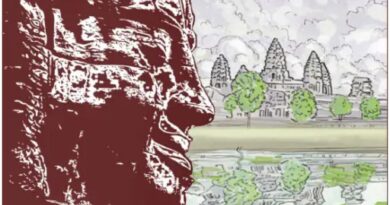ក្រោមកិច្ចសហការរវាងអាជ្ញាធរជាតិអប្សរា និងទីភ្នាក់ងារសហប្រតិបត្តិការអន្តរជាតិកូរ៉េ(KOICA) នៅថ្ងៃទី១៥ ខែមីនា ឆ្នាំ២០២៣ តាមរយៈមូលនិធិបេតិកភណ្ឌកូរ៉េ (KCHF) បានបើកវគ្គបណ្តុះបណ្តាលរយៈពេល៤ថ្ងៃ គឺពីថ្ងៃទី១៣-ខែមីនា រហូតដល់ថ្ងៃទី១៦ ខែមីនា ដល់មន្ត្រី បុគ្គលិកបច្ចេកទេសអាជ្ញាធរជាតិអប្សរាអំពីការប្រើប្រាស់ម៉ាស៊ីន GPR (Ground Penetrating Radar)ដើម្បីសិក្សាស្រាវជ្រាវអំពីបុរាណវត្ថុនៅក្រោមដីក្នុងតំបន់អង្គរ។
លោក Hyundok Oh ជាភូគព្ភវិទូផ្នែកបុរាណវិទ្យាកូរ៉េ នៅ វិទ្យាស្ថានជាតិស្រាវជ្រាវបេតិកភណ្ឌវប្បធម៌ (NRICH) មានប្រសាសន៍ថា ជាទូទៅបុរាណវិទូតែងតែប្រើប្រាស់វិធីធ្វើកំណាយដើម្បីសិក្សាស្រាវជ្រាវអំពីបុរាណវត្ថុ ឬ រចនាសម្ពន្ធសំណង់ដែលនៅក្រោមដី។ ការធ្វើកំណាយបែបនេះ ទាមទារនូវកម្លាំងពលកម្ម ពេលវេលា និងការចំណាយថវិកាច្រើន។ ប៉ុន្តែដោយសារបច្ចុប្បន្ននេះ បច្ចេកវិទ្យាមានការរីកចម្រើន គេបានប្រើប្រាស់ម៉ាស៊ីន GPR ដើម្បីស្កេនរកមើលបុរាណវត្ថុដែលមាននៅក្រោមដីដែលជាជំនួយដល់ការសិក្សាស្រាវជ្រាវ ដោយវាចំណេញទាំងពេលវេលា ទាំងកម្លាំងពលកម្ម និងថវិកាទៀតផង។
លោកបានបន្តទៀតថា វគ្គបណ្តុះបណ្តាលនេះ គឺបានផ្តោតទៅលើការសិក្សាទាំងទ្រឹស្តី ទាំងការអនុវត្តប្រើប្រាស់ម៉ាស៊ីន GPR និងបានសិក្សាពីរបៀបប្រើប្រាស់កម្មវិធីម៉ាស៊ីន GPR តភ្ជាប់ទៅនឹងកម្មវិធីក្នុងប្រព័ន្ធកុំព្យូទ័រ។ ម៉ាស៊ីន GPR សម្រាប់ស្កេនរក មើលវត្ថុនៅក្រោមដីនេះប្រៀបដូចទៅនឹងម៉ាស៊ីន X-RAY សម្រាប់ស្កេនលើដងខ្លួនមនុស្សដែរ។ ម៉ាស៊ីន GPR ត្រូវភ្ជាប់ខ្សែ ទៅនឹងកុំព្យូទ័រដើម្បីធ្វើការបង្ហាញនូវទិន្នន័យសម្រាប់ធ្វើការវិភាគ ប៉ុន្តែទោះបីយ៉ាងណាក៏ម៉ាស៊ីន GPR មិនបានបង្ហាញភាព ត្រឹមត្រូវ និងច្បាស់លាស់ដូចទៅនឹងការធ្វើកំណាយដោយដៃផ្ទាល់នោះទេ។ លោកសង្ឃឹមថា សិក្ខាកាមទាំងអស់ដែលបាន ចូលរួមវគ្គបណ្តុះបណ្តាលនាពេលនេះនឹងទទួលបានចំណេះដឹង ទាំងទ្រឹស្តី និងការអនុវត្តក្នុងការប្រើប្រាស់ម៉ាស៊ីន GPR នេះ ហើយនឹងយកចំណេះដឹងនេះទៅប្រើប្រាស់សម្រាប់ធ្វើការសិក្សាស្រាវជ្រាវនៅកន្លែងបុរាណដ្ឋានផ្សេងៗទៀត៕
អត្ថបទ៖ ឆាយ ផាន់នី
រូបភាព៖ លោក យី សុថា
In collaboration with APSARA National Authority and Korea International Cooperation Agency (KOICA) on 15 March 2023, through the Korea Cultural Heritage Foundation (KCHF), a four-day training course has been held from March 13 to 17 March for technical staff of APSARA National Authority to use GPR (Ground Penetrating Radar) to study underground archeology in the Angkor area.
Hyundok Oh, an Archaeological Geophysicist at the National Research Institute of Cultural Heritage (NRICH), said that archaeologists often use excavation methods to study archeological sites or underground structures. Such excavations require a lot of labor, time, and money. But with the advent of modern technology, GPR machines have been used to scan for archeology underground, aiding in research, which saves time, labor, and money.
He added that the training focused on the study of both the theory and practice of using GPR machines and how to use GPR machine software to connect to computer programs. The GPR scanner is similar to the X-RAY scanner. GPR machines need to be wired to a computer to display data for analysis, however, GPR machines are not as accurate and precise as manual excavation. He hoped that all participants who attended the training will gain both theoretical and practical knowledge in the use of GPR machines and will use this knowledge to conduct research at other archeological sites.
Article: Chhay Phanny
Photos: Mr. Yi Sotha
Share:
Our Latest News

សេចក្តីជូនដំណឹង ស្ដីពីការដាក់ឱ្យប្រើប្រាស់សាកល្បងកម្មវិធី Visit Angkor – 09 May 2025
ដើម្បីទាញយកកម្មវិធីVisit Angkor៖




